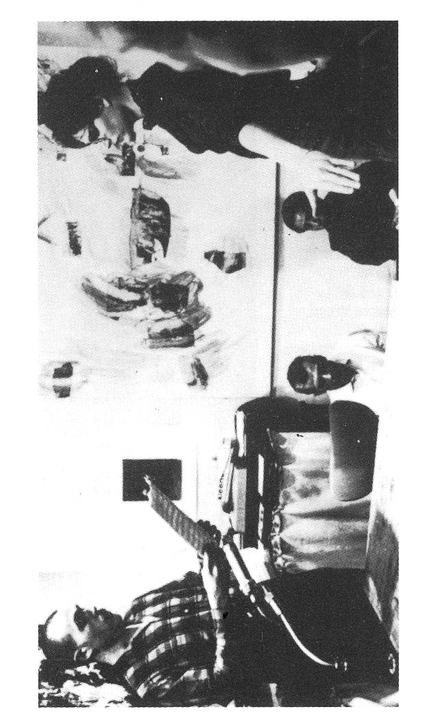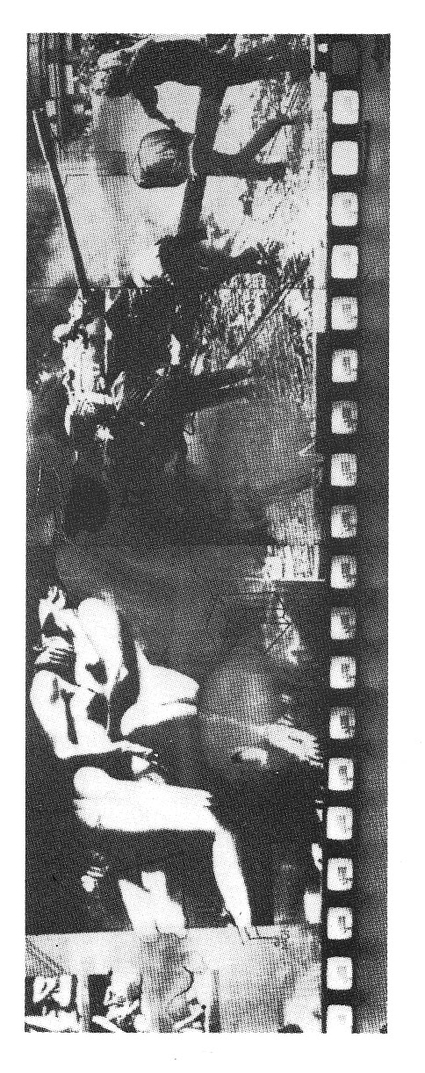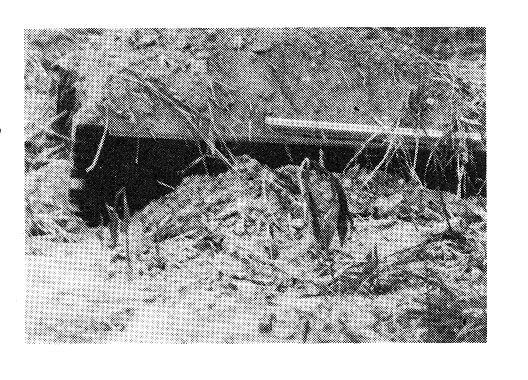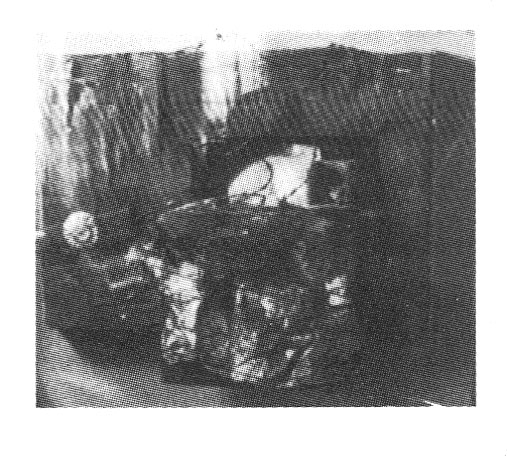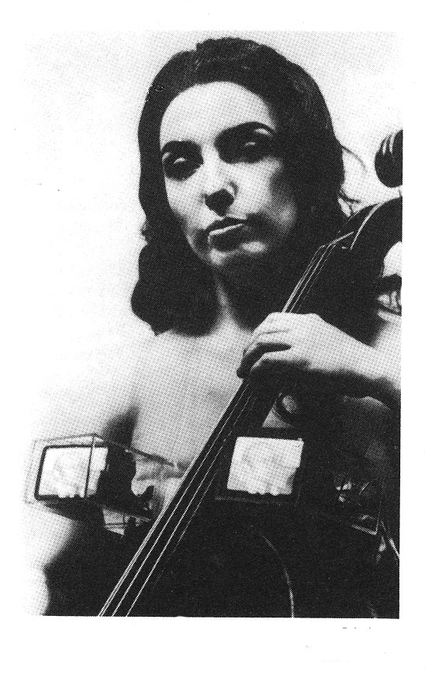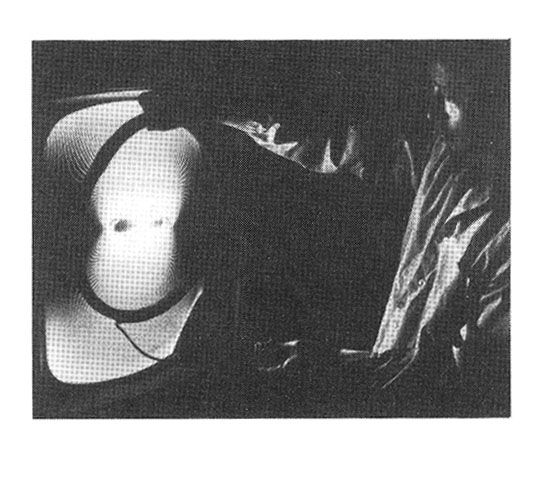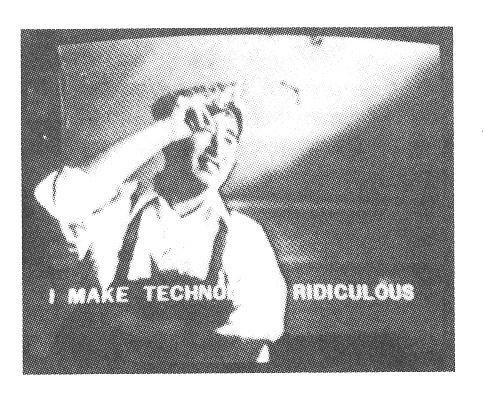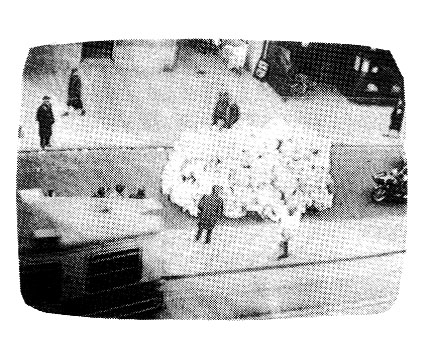Parallele Aufführungen Neuester Musik
John Cage Solo for voice no.2 performed by Dick Higgins and Alison Knowles
MACIUNAS strove for rigorous changes in art. For him art was a way to promote a particular attitude, a process had to be started in which everyone would achieve an attitude to life inspired by art. This would cause the art and the attached institutions to be made superfluous and, in the end, to be eliminated. This object had to be reached through the cooperative efforts of as many artists as possible.
Many artists in the USA took part in the FLUXUS activities organized by MACIUNAS. In November 1961 MACIUNAS left for Europe where in September 1962, in Wiesbaden, the first European Fluxus Festival was staged. Information in Germany on FLUXUS was propagated by the German artist WOLF VOSTELL (1932). A month after their performance at the Wiesbaden festival, VOSTELL took the international FLUXUS party to Amsterdam, There, at the GALERIE MONET were staged the Parallele Aufführungen Neuester Musik, the first happening in the Netherlands.
In 1964 rising tension between VOSTELL and MACIUNAS created a rift within the movement, FLUXUS however was not to come to an end until the late '70s.
The character of FLUXUS was very conflicting and non-committal. This was caused on the one hand by the lack of logical coherence, and on the other by all participating artists using their own definitions. As a result there is no FLUXUS ideology as such, at best one can define a number of characteristics.
They wanted to create a concrete form of art, devoid of references. Several disciplines of art were represented: ballet, theater, poetry, visual arts, cinematography and video, but above all music. Artists with a musical interest wanted to give music a concrete form through audience participation. This idea they borrowed from the American composer JOHN CAGE. CAGE held the opinion that the noises made by the audience during the concert, were part of the performance. This way the structure was jointly defined by the listener. Therefore such a concert was very loosely defined and could end up a multimedial affair. Many FLUXUS artists developed this idea further and tried working with every possible medium.
The interdisciplinary character of FLUXUS also spread to spheres outside art. For the realization of their ideas they sought contact with scientists and engineers.
Although FLUXUS displayed a critical attitude towards technology and tried to find alternative solutions to existing social and artistic situations, it cannot be considered a political organization.
Wolf Vostell Heuschrecken 1969/70
Television Video
In the Sixties the prosperity of the western nations and the USA increased and technology became more accessible, and became integrated in society. This situation is well described by REYNER BANHAM in his book Theory and Design in the First Machine Age: ...and what appeared to be a second machine age as glorious as the first (technical developments between 1900 and 1930, MAR) beckoned us into the Fabulous Sixties - miniaturization, transistorization, jet and rocket travel, wonder-drugs and new domestic chemistries, television and the computer seemed to offer more of the same only better. What had been promised by the First Machine Age, but never properly delivered, now seemed to be at hand.
Indeed in this period a television set had become an established household appliance. In the USA the mass production of television sets had started after WW 2 . Soon the public started buying the sets en masse. From 1948' onwards the American local televisions stations and the national TV networks started regular transmissions. Europe only reached this stage in the fifties.
However the technological developments were nor accepted offhand, as one was well aware of the possible negative applications. The horrors of the Second World War and Viet-Nam proved this point. Moreover it soon became apparent that television like radio was only going to be used in one-way traffic and not for real communication.
The Viet-Nam War (1964-1975), one of , the most dramatic events of the decade, was the first of the so-called TV -wars.
Reports on the war were shown on the news and in commentaries next to entertainment and commercials. Thus a large discrepancy existed between the offerings on the screen, without this receiving much emphasis. All classes of information were reduced to the same level.
When artists started using video, their works showed positive and negative views on technology. A lot of video-art referred to television.
Wolf Vostell TV- Burying 1963
On the one hand the artists were thinking towards an Utopian society in which the mass-media would only be used for positive goals. They owed these views to the, in those days very influential, theories of, MARSHALL MCLUHAN (1911-1980), a Canadian cultural philosopher and expert on the mass-media. He thought that the explosion of electronic ways of communication would create a new way of perception. He looked upon all modern media as an extension of the human nerve-system which consequently would spread over the whole world. Through this extensive communication-network people would be drawn closer and a new society, the global village, would be formed.
On the other hand the artists considered that for several reasons the way the mass media were used had to be denounced. The main reasons were: the fact that television was not freely accessible but monopolized by TV networks and broadcast-companies, the watering down of information by the programme-directors, the uni-directional character of television and the fact that television represented the establishment.
Many works of video art from the sixties unite negative and positive criticism on the mass media and offer alternatives for the usual approach to television.
WOLF VOSTELL
The two most important artists of FLUXUS working with video were NAM JUNE PAIK and WOLF VOSTELL.
VOSTELL's starting-paint was his theory of Dé-coll/age, which stands for an omnipresent process of decomposition and wear. This conception covers all destructive action. In his oeuvre he used destructive techniques and showed objects or concepts torn out of context in a new framework. He wanted to confront his public with fear, destruction and human distress, to achieve a therapeutical effect.
His works were always critical of society. He tried to detach himself from the stigma of the artist as the suffering individual. As he considered art and life to be equal, he thought artists had to take joint responsibility for history. Although MACINUAS was of the same opinion, he lacked the political aspect.
VOSTELL joined FLUXUS out of musical interest. For him visual art and music were not very far apart: in the arts, when time is used as a material, one is composing. He made Dé-coll/age music with homemade instruments, to reproduce the sounds of destruction.
In 1958 en 1959 there appeared for the first time in his notes directions for the use of film and video in art. His first work of TV art, Schwarzes Zimmer (1958), can be seen as a forerunner of the video-installation. A television set wrapped in barbed wire and with a distorted picture and several objects which were reminiscent of the mass-murders of Treblinka and Auschwitz were exhibited in a triangular setting. Schwarzes Zimmer referred to the misuse in Nazi-Germany of the mass-media as a tool for manipulation. Till through the sixties Vostell kept applying himself to the deformation of the picture or the TV set itself. Again and again he would involve other media. At the Yam Festival (New Brunswick, USA, 1963) he buried a television set while it was operating, The same year, he organized the happening 9 Dé-coll/agen in Wuppertal. During the performance he showed images distorted in a special way: he projected a movie of images taken from a TV screen. Also he had a TV set implode.
In 1968 he exhibited the environment Electronischer Décoll/age Happening Raum in Nuremberg. This was the work of video art which best expressed the influence of FLUXUS, although he had severed connections with the movement some years before. He used a television set for its musical properties. A defective, noise producing TV set functioned within this environment as a Dé-coll/age musical instrument.
Heuschrecken (1969) is the first real video installation made by WOLF VOSTELL . The entering visitor appeared on 20 monitors simultaneously. Two gigantic pictures were shown above the row of monitors: an erotic photography and a war scene. With Heuschrecken Vostell criticized the equalization of the various grades of information in the media. At the time this work was made, the Vietnam War was underway, therefore it is not unlikely that he has made this work referring to the reports on this war.
All these works of art severely criticized the traditional use of the media. At times Vostell used this to give the media a new function as in 9 Dé-coll/agenor in Electronischer Dé-coll/age Happening Raum.
NAM JUNE PAIK
PAIK (1932) joined FLUXUS in 1962, after he had met, MACIUNAS in Germany. Hence from he would participate in several FLUXUS-activities like the festival in Wiesbaden and the Paralelle Auffführungen Neuester Musik in Amsterdam.
NAM JUNE PAIK was first of all a composer who was fascinated by the ideas of JOHN CAGE. PAIK saw the extension of concerts into multimedial spectacles as a way to visualize music. Before he was to concentrate himself on electronical image-forming, he experimented with electronic music. A logical step towards realizing the visualization of this music appeared to him to be to use TV and video. This way of thinking was typical for the interdisciplinary approach, practiced by this. FLUXUS-artist of the first hour. He looked upon video as a medium that would unite the different branches of music, painting, film and theater. He held the view that in the future video would replace the traditional techniques of painting.
Nam June Paik TV-Bra for Living Sculpture 1972 with Charlotte Moorman
Audience-participation, for which video is a highly suitable medium, also played an important role in his work, as with many other FLUXUS-artists.
PAIK wanted to use technology to bring people closer together, he wanted to humanize technology. In his theoretical work from the sixties (Utopian laser TV-station (1966), Expanded Education for the Paperless Society and Global University (1968) he incorporated many ideas from MARSHALL MCLUHAN. He believed like MCLUHAN that the era in which all information was in the way of writing, would peter out and be superceded by a TV age in which all information would be visual and distributed by satellites. However he did consider the forming of stations, independent of networks and commerce, a prerequisite to exploit the educational and interactive possibilities of TV . Only thus could a Global University be originated in which artists too would have their place.
Nam June Paik with magneto- coil 1965
PAIK too was not uncritical of the way technology was used in society. Once he said he used technology to be able to hate it even more. In his TV and video works he combined his criticism with research. By distorting the images and by placing video or TV sets in surroundings where they didn't belong he arrived at new aesthetics. In 1963 his first TV environment was on show at the GALERIE PARNASS in Wuppertal. Several rooms were used and different objects displayed. One room was filled with eleven television sets, all with a distorted picture. Their original function was replaced by a new one: that of a musical instrument creating images.
Nam June Paik 1975
In 1965 NAM JUNE PAIK was the first artist to employ a video camera: he made recordings of the papal visit to New York. The tape, called Electronic Video Recorder, was played in CAFé à GOGO (New York). Electronic Video Recorder showed the possibilities of video as an alternative television without directly attacking the television establishment.
In his Participation TV projects, the first dates from 1965, we find an implicit attitude against the makers of television. PAIK had the audience distort the picture of a TV set with magnets or microphones. In 1969 two other Participation TV projects were staged in the New York GALERIE HOWARD WISE, which had also staged the first.
Electronic Opera no. 1 (1969) was part of The Medium is the Medium, a TV program made by artists, and broadcast by WGBH-TV of Boston. PAIK had made a compilation of takes of a dancer, hippies, two lovers, synthesized images and TV -shots of NIXON. These fragments were at times distorted. The viewer was for instance instructed to close his eyes or to switch of the set. This way PAIK broke down the conventional (visual) codes of television, replaced them with a new language and used the medium for bi-directional communication.
His TV - Bra for Living Sculpture (1969) was again performed in the GALERIE HOWARD WISE. The cellist CHARLOTTE MOORMAN played her instrument dressed in a brassiere of which both cups were replaced by monitors. The different tones kept changing the image on the screens. By creating an association with an object that close to the body, NAM JUNE PAIK strived to humanize television. At the same time he showed how television made people dependent by comparing it with breast milk. Of course also the visualization of music was a main theme of TV Bra for Living Sculpture.
PAIK incorporated his attacks on those in charge of the media in playfull works of art in which the public usually had to take part. Thus illustrating that art and life do not have to be so far apart.
The Netherlands
In the Netherlands it was WIM T. SCHIPPERS (1942) who as a FLUXUS-artist turned against the TV culture. In discordance with his foreign colleges he operated within the established circuits.
In 1962 SCHIPPERS had already applied himself to activities allied to FLUXUS when in 1963 he took part in Internationaal Programma Nieuwste Muziek-Nieuwste Theater- Nieuwste Literatuur. This was one of the FLUXUS festivals organized in the Netherlands. It took place in the KLEINE KOMEDIE in Amsterdam. From then on he would participate in the Dutch FLUXUS-activities until 1966, the year he and DE RIDDER made a special FLUXUS-edition of the paper Kunst van Nu. After that the FLUXUS-activities in the Netherlands would come to an end.
SCHIPPERS used many different media: visual arts, printing, music, film and TV . His art was concrete and showed a sense of humor.
In 1963 SCHIPPERS and DE RIDDER were asked by director HENK DE BIJ to take charge of the VARA program Signalement. This would be the beginning of the multitude of TV activities of SCHIPPERS. In this program he and DE RIDDER discussed in a very personal style the recent developments in modern art. Their own projects came up too, as with SCHIPPERS emptying of a lemonade-bottle into the sea, and DE RIDDER's Papieren Canstellaties. The presentation was fast and businesslike and the unwritten rules of television were subtly made a fool of.
Hoepla was broadcast by the VPRO in 1967 and 1968. It was put together by TRINO FLOTHUIS, WIM VAN DER LINDEN, WIM T. SCHIPPERS and HANS VERHAGEN. Hoepla was a youth-magazine in which (for those days) controversial subjects passed in review. The authors strove to give the programmes an amateuristic and chaotic character and thus kicked against the conventions of TV-esthetics.
If we compare the aforementioned artists we can conclude they all shed a new light on the use and function of TV and video. VOSTELL's work can be titled as serious. They posses a clear message to the public to improve society. NAM JUNE PAIK too criticized society, but in a more light- hearted manner. For him the experiments with the equipment and the musical aspects were just as important. For WIM T. SCHIPPERS the emphasis rested on the content and the way of presentation. The social values and standards were the material he experimented/s with.
If you'd like to quote something: Rajandream, Marie-Adèle. "Fluxus + Video." Mediamatic agazine vol. 1 # 2 (1986).
Lucinda Furlong Notes toward a history of image-processed video, Steina and Woody Vasulka, in: Afterimage december 1983
Jürgen Schilling Fluxus, in: Aktionskunst. Identität von Kunst und Leben? Frankfurt 1987
H. Ruhé Fluxus the most radical and experimental art movement of the sixties, Amsterdam 1979
H. Ruhé Over schilderkunst, nieuwe media en het avontuur van Fluxus in: De Nederlandse identiteit in de kunst na 1945, Amsterdam 1984
W. Herzogenrath, S. Schreiber Nam June Paik, Fluxus-Video, München 1983
cat. Actie, werkelijkheid en fictie in de kunst van de jaren '60 in Nederland Museum Boymans-van Beuningen, Rotterdam 1984
Paul Donker Duyvis Wim T. Schippers in: Kunstschrift 4 Weesp 1984
Reyner Banham Theory and Design in the First Machine Age, London 1982
Jennifer Smit Agressie in de Fluxus-beweging in: Museumjournaal 2 Amsterdam 1979
Translation: Marten Gerritsen
